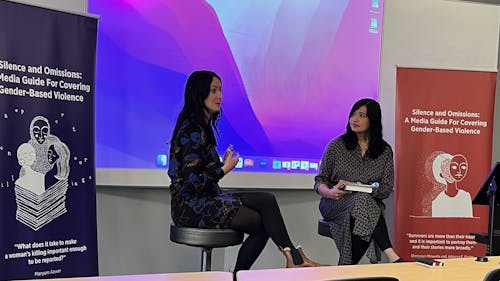School of Communication and Information event discusses reporting on gender-based violence

Last month, the Rutgers School of Communication and Information hosted an event that discussed the publishing of the guidebook "Silence and Omissions: A Media Guide for Covering Gender-Based Violence."
The guide, which was published in 2022, was produced by the Journalism Initiative on Gender-Based Violence (JiG) at the Rutgers Institute for Women's Leadership.
Two speakers led the event: Cathy Otten, the senior program lead for JiG, and Nikhila Natarajan, a PhD student in the School of Arts and Sciences.
Natarajan said the guidebook aims to help journalists report instances of gender-based violence through a lens of human rights and survivorship.
Otten, who is also a visiting global associate at the Center for Women's Global Leadership (CWGL), said violence against women is a political issue and should be reported as such. She said the guide also urges reporters to prioritize the safety of interviewees.
"(Asking interviewees) 'Where would you like to be interviewed?' 'Do you feel comfortable? 'Who else should be in the room?' — these sorts of questions," Otten said.
Krishanti Dharmaraj, CWGL's former executive director, said the JiG initiative used to be connected to the Center, which closed during the Fall 2022 semester, as The Daily Targum previously reported.
Dharmaraj said the project first emerged in 2017, when she and Cosette Thompson, an affiliate of the CWGL, decided to conduct an analysis of the Center's 16 Days Campaign, a global initiative to end gender-based violence.
Thompson said her research revealed the media to be both an ally and barrier to the campaign, because the press often either short-changed or misinterpreted the campaign's message.
"The two main arguments, I would say, were that in many instances, although the media would cover the 16 Days campaign activities and messages, they would do it in a way that really, completely, was very misguided, and that absolutely did not convey the central messages of the campaign and its central aims," she said.
Between 2018 and 2021, representatives from the Center met with journalists from around the world to discuss their experiences reporting on gender-based violence, Dharmaraj said.
Two years ago, she obtained $225,000 from the Future Fund to support JiG's work, which included publishing the media guide on gender-based violence, she said.
Thompson said that during these discussions, journalists expressed the need for concise, educational resources on gender-based violence, with many citing poor educational and professional experiences with reporting on the subject.
Reasons for these subpar experiences include journalists having different levels of education and training as well as dealing with misogyny within the workplace, she said.
"(The journalists) said 'we badly need a one-stop-shop that would support our work and really highlight the link between the local manifestations of gender-based violence and the global manifestations,'" Thompson said.
Other significant barriers for journalists who report on gender-based violence include self-censorship due to a lack of knowledge on the subject, threats to their jobs or experiences with sexual harassment and discrimination, Thompson said.
Otten said issues like gender-based violence often remain undiscussed in newsrooms since many outlets are influenced against reporting them by their political affiliations and sponsors.
"Newspapers and TV stations have to appease advertisers, so there's less reason for them to go into the details of why something happened and how we can change it and can change society," she said.
Thompson said that when reporting on gender-based violence, it is essential to incorporate adequate context for individuals to identify the underlying causes and trends of the issue — which can be beneficial for producing potential solutions to the problem.
In the future, Otten said she hopes the media guide, which is currently available in print and online, becomes part of collegiate education and becomes significant in the public sphere. Though expanding its reach in those areas would require funding, she said.
"We also want (the guidebook) to become a tool that's actively used by newspapers, to take the lessons from it and turn them into policy," she said. "Both within media organizations, maybe at some point as curriculum in university, talking to departments ... as well developing a module based on the guide and then eventually maybe even having it in policy."



